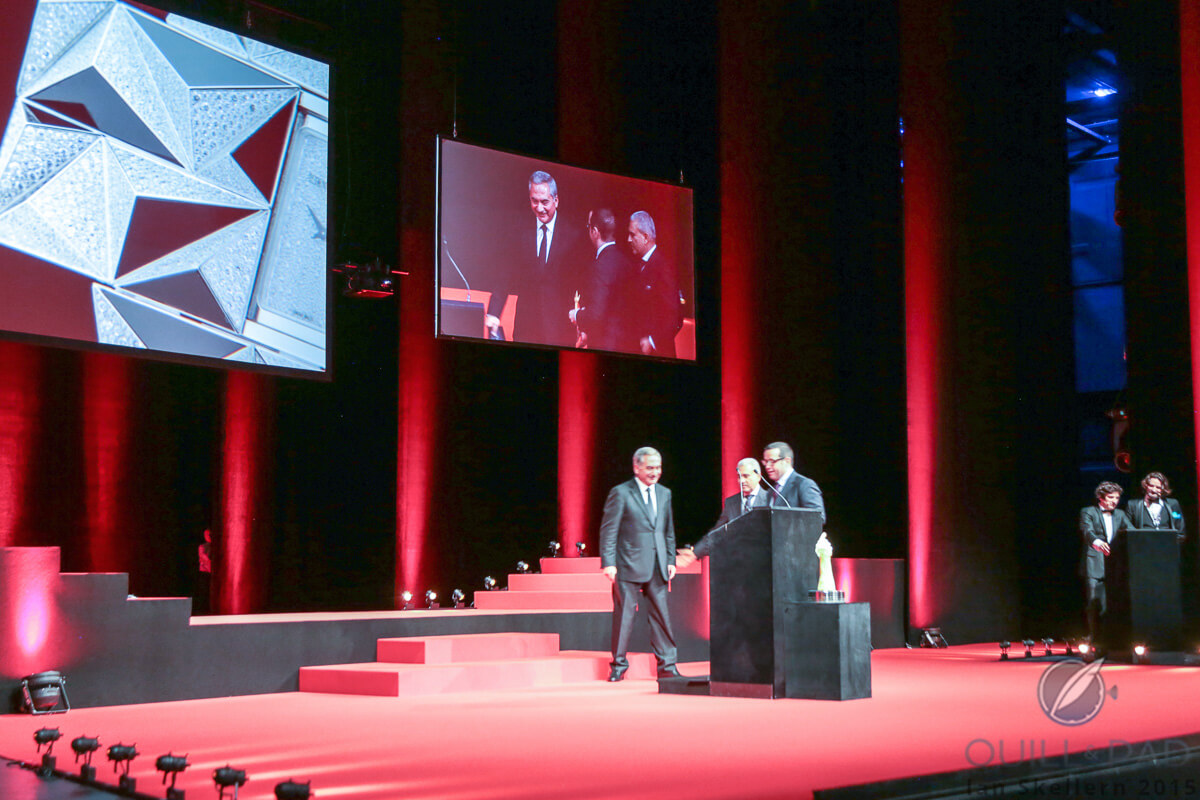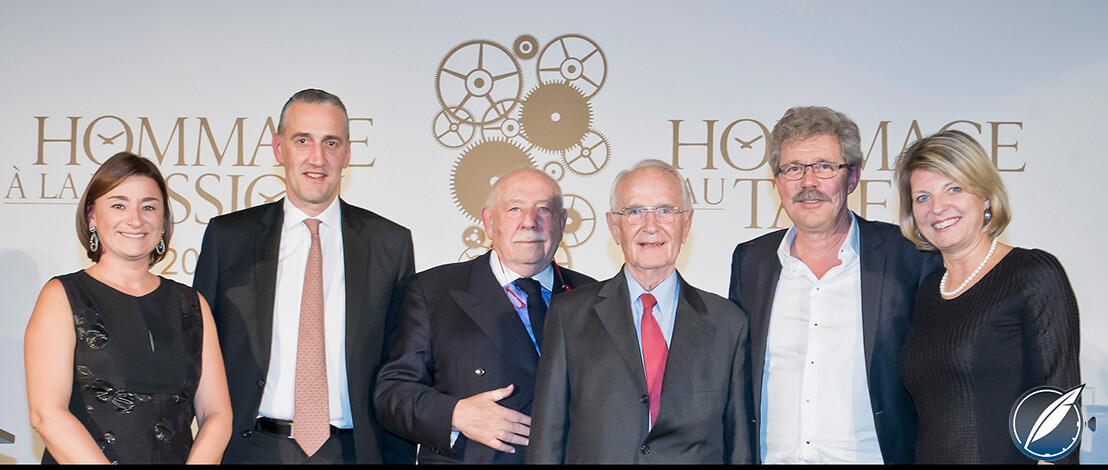In perusing the names of the 2020 jury of the Grand Prix d’Horlogerie de Genève, two distinct things became obvious: the entire jury is based in Switzerland and it is far less diverse than it has been over the last decade.
It was foregone conclusion to me that this year’s jury would be chosen from among the GPHG Academy’s Swiss residents: the ongoing COVID-19 crisis has made travel once again all but impossible. This way, the jury has both the option of meeting in person safely and attending the award ceremony on November 12 should an in-person event be possible.

The 2019 GPHG jury along with the evening’s winners on stage: big changes are underway in 2020
However, this means that the diversity of the jury has been drastically reduced and features only six women (22 percent of the total).
Of this list of 30, also only six people have previously been on the jury at some point: René Beyer, Philippe Dufour, Gianfranco Ritschel, Pierre Salanitro, and Patrick Wehrli. Aurel Bacs returns as jury president, a position he has fulfilled since 2011 if memory serves.
Composition of the GPHG 2020 jury
Here is a listing of the new jury members, broken down by occupation. Some names are listed twice in my breakdown since these people may fulfill more than one occupation.
Watchmakers: Pierre Amstutz (director of the Geneva Watchmaking School), Denis Asch, Vincent Calabrese (co-founder of the A.H.C.I.), Philippe Dufour, Jean-Michel Piguet (president of Chronométrophilia), Gianfranco Ritschel (Fondation de la Haute Horlogerie trainer), Patrick Wehrli, Jean-Marc Wiederrecht (Agenhor)
Suppliers: Isabelle Chillier (Fiedler/watch hands), Eric Giroud (designer), Denis Hayoun (photographer), Georges Humard (Humard Automation/large machinery), Jean-Noël Lefèvre (Vaucher/movements), Hubert Lorenz (Mimotec/LIGA and silicon components), Pierre Salanitro (Salanitro/gemsetting), Elisabeth Saulcy (STS Saulcy Traitement de Surface/finishing, decorating movements), Jean-Marc Wiederrecht (Agenhor)
Retail: René Beyer (Beyer), Denis Asch (previous owner of L’Heure Asch), Ignaz Steg (Les Ambassadeurs), Antonio Teixeira (Bucherer), Aurel Bacs (Phillips)
Consultants: Alexandre Favez (has worked behind the scenes for the GPHG foundation since 2003 preparing the competition watches, for example), Denis Asch, Patrick Wehrli, Alexander Friedman (co-founder Watchonista)
Journalists/publishers: Marie de Pimodan (freelance writer), Alexander Friedman (co-founder Watchonista; this organization is not purely journalistic and also works for brands hence the inclusion in “consultants”), Brice Lechevalier (Worldtempus/GMT/Skippers), Pierre-André Schmitt (Watch Around), Caroline Spir (l’Agefi Life)
Educators: Pierre Amstutz, Gianfranco Ritschel, Valérie Ursenbacher (designer/watch design chair at HEAD University of Art and Design in Geneva)
Miscellaneous: Fabienne Lupo (previous president of Fondation de la Haute Horlogerie/Watches & Wonders), Jean-Michel Piguet, Guy Sémon (previous head of LVMH’s research and development department), François-Henry Bennhamias, CEO of Audemars Piguet (the previous year’s winner of the Aiguille d’Or joins the jury for one year and that brand may not enter a watch).
My thoughts on the jury
First off, my thoughts as to the diversity factor. I know firsthand that Carine Maillard, director of the GPHG since 2011, has put quite a bit of effort into having more women represented on the jury. It’s hard to fault this aspect of the composition as I know that effort was certainly made in this direction, but of course I would have wished for more female representation.

Hard at work: members of the 2019 GPHG jury deliberating on selection day, including Bovet CEO Pascale Raffy (at left)
As to the diversity of the jury, not including gender, with COVID-19 travel restrictions in place and the future of anything very, very hard to see in either the short or long term, the decision to stay within Switzerland’s borders should ensure that the event has its best chance of going forward. Voting day is the most important element as handling the finalist watches and discussing them with colleagues is the most critical step in determining winners. It is impossible to fairly judge categories, especially Artistic Crafts and Jewellery, without actually handling the timepieces.
Whether the final event ends up being digital – not a bad concession – or in person with a restricted number of guests, the main work will have been accomplished and awards can be handed out.
As you can see in my breakdown, the number of technicians on the jury has been pushed up extensively, whether trained watchmakers or owners/CEOs of suppliers to the watch industry. The total count of such people is 15 (16 if you include Sémon), (more than) half the jury. I consider this a good thing.

Audemars Piguet CEO François-Henry Bennahmias accepting the best Jewellery prize at the 2015 Grand Prix d’Horlogerie de Genève for the Diamond Punk from Claude Sfeir and Ahmed Seddiqi
There are three strong active retailers on the jury and other people representing various brand interests such as Audemars Piguet CEO Bennahmias – though in theory he should be neutral during the discussions; I have observed various CEOs in past discussions in the room as being very non-present, not wanting to give any type of false impressions and certainly not volunteering to be in the sometimes loud and passionate talks that take place. I would have been very interested to see Bennahmias in this year’s discussions as he is a different type of personality. But back to the subject at hand: this is not too much “brand presence” on the jury to make a real biased difference.
I applaud as loudly as I possibly can the inclusion of Jean-Marc Wiederrecht, Valérie Ursenbacher, and Fabienne Lupo on this jury, three excellent voices with deep-founded knowledge and fair attitudes. I have known Wiederrecht for too many years to count, and there is hardly a more interesting, balanced, and knowledgeable discussion partner on the planet. As he was to the FHH Cultural Council a few years ago, here he will make for an expert addition with impressive insights that he is not afraid to share in his humble, yet compelling manner.

Fabienne Lupo (far left) and Jean-Marc Wiederrecht (second from right) at the FHH Homage à la Passion event in 2013 (this photo also includes Franco Cologni, Walter Lange, and Catherine Wiederrecht)
I worked with Lupo on the FHH Cultural Council for a good decade, and I have come to know and greatly respect her. I had hoped she would join the GPHG jury previous to this, but I am glad she is here now. She too will be able to bring a balanced look to things, I’m sure. And I know she knows how to get her opinion across.
If you’re of a certain age, you might remember Ursenbacher as one of the three designers that made up HD3 Complication, a short-lived company that existed in the boom years of the mechanical renaissance (2000-2011). It came forth from the design department of Jörg Hysek’s company (Hysek was one of the other two designers involved). After spending many years as a freelance designer, Ursenbacher started teaching at HEAD in 2015 and is now the chair of watch design. She is an excellent and visionary designer.
Summing up, this is a fair and balanced jury, and I would have looked forward to hearing some of the more industrially minded opinions that are bound to shine here (though as per the rules I never will). There are a lot more industry insiders present here than usual, which may tip some judgements differently than previous years’ more diverse juries – diverse in terms of knowledge level and geographical influence above all.
As you can also plainly see in our various GPHG round tables, this is bound to be a very interesting year for the Grand Prix d’Horlogerie de Genève.
For more information, please visit www.gphg.org/horlogerie.
You may also enjoy:
Leave a Reply
Want to join the discussion?Feel free to contribute!





















































Why do you equate “diversity” (assuming of thought) with gender and skin colour? That’s a very racist and sexist view of the world, ’cause i assure you with 100% certainty that a straight white male from Greece and one from northern Russia will have much more diverging thoughts on nearly everything than a bisexual black woman and homosexual asian man if they’re both from middle-class San Franciso.
can’t believe i’m reading this drivel on a watch site…
Who said anything whatsoever about skin color? And as you might have noticed, I discussed gender separately. The rest is your interpretation.
As far as I can say … I enjoyed this article a lot because of its behind the scenes detailed background information. It is a rare find to have articles like this in the watch news or websites.
What fascinates me the most is to see the effect of the new GPHG vote and nomination procedures on the result and on the winners this year. The academy, the nomination round, the voting rounds, the weigthed vote shares, the jury. Cool to see the effects of this reform. It is a bit like constitutional engineering (like making and breaking rules and bills in the EU-system). I like this. Unfortunately the virus effect on an event like this mixes up this “experiment”. I hope all can take place and I can see some reform effects on this years GPHG. Thanks for the additional information dear Elizabeth.
Thomas 37 Grad
Thanks for your observations, Thomas! I wish this new format had been able to go forward as originally planned as it would have been a very interesting experiment. But what we have now is also interesting. I am very excited to see the continuation.
One question if you allow dear Elizabeth: It is written, that the Jury is composed of 30 members from the ACADEMY (the full body of more than 350something). It also says: 14 members are DRAWN AT RANDOM from the Academy (spread between the various colleges, apart from the college of brands). 15 members ARE CHOSEN by the GPHG from within the Academy, and 1 representative of the brand that won the “Aiguille d’Or” Grand Prix the previous year (15 + 14 + 1 = 30). Did they draw the 14 this year or do they CHOSE all (14 plus 15) this year by the GPHG because of the pandemic situation we are in? Do you know? Danke vielmals.
I don’t know 100% sure as it was never announced, but my guess is that they chose 14 randomly from among the Swiss residents. And that would make sense to me. Keeping the jury Swiss this year was probably the only “best option.”
Swiss means neutrality – or ‘anyway: chumm mir wei nid grüble.’ (W. Ludin)
🙂